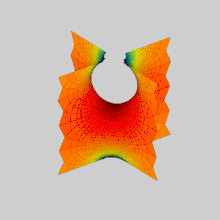Scherk surface
From Wikipedia, the free encyclopedia
In mathematics, a Scherk surface (named after Heinrich Scherk) is an example of a minimal surface. Scherk described two complete embedded minimal surfaces in 1834;[1] his first surface is a doubly periodic surface, his second surface is singly periodic. They were the third non-trivial examples of minimal surfaces (the first two were the catenoid and helicoid).[2] The two surfaces are conjugates of each other.

Scherk surfaces arise in the study of certain limiting minimal surface problems and in the study of harmonic diffeomorphisms of hyperbolic space.
Scherk's first surface
Summarize
Perspective
Scherk's first surface is asymptotic to two infinite families of parallel planes, orthogonal to each other, that meet near z = 0 in a checkerboard pattern of bridging arches. It contains an infinite number of straight vertical lines.
Construction of a simple Scherk surface


Consider the following minimal surface problem on a square in the Euclidean plane: for a natural number n, find a minimal surface Σn as the graph of some function
such that
That is, un satisfies the minimal surface equation
and
What, if anything, is the limiting surface as n tends to infinity? The answer was given by H. Scherk in 1834: the limiting surface Σ is the graph of
That is, the Scherk surface over the square is
More general Scherk surfaces
One can consider similar minimal surface problems on other quadrilaterals in the Euclidean plane. One can also consider the same problem on quadrilaterals in the hyperbolic plane. In 2006, Harold Rosenberg and Pascal Collin used hyperbolic Scherk surfaces to construct a harmonic diffeomorphism from the complex plane onto the hyperbolic plane (the unit disc with the hyperbolic metric), thereby disproving the Schoen–Yau conjecture.
Scherk's second surface
Summarize
Perspective


Scherk's second surface looks globally like two orthogonal planes whose intersection consists of a sequence of tunnels in alternating directions. Its intersections with horizontal planes consists of alternating hyperbolas.
It has implicit equation:
It has the Weierstrass–Enneper parameterization , and can be parametrized as:[3]
for and . This gives one period of the surface, which can then be extended in the z-direction by symmetry.
The surface has been generalised by H. Karcher into the saddle tower family of periodic minimal surfaces.
Somewhat confusingly, this surface is occasionally called Scherk's fifth surface in the literature.[4][5] To minimize confusion it is useful to refer to it as Scherk's singly periodic surface or the Scherk-tower.
External links
- Sabitov, I.Kh. (2001) [1994], "Scherk surface", Encyclopedia of Mathematics, EMS Press
- Scherk's first surface in MSRI Geometry
- Scherk's second surface in MSRI Geometry
- Scherk's minimal surfaces in Mathworld
References
Wikiwand - on
Seamless Wikipedia browsing. On steroids.
















